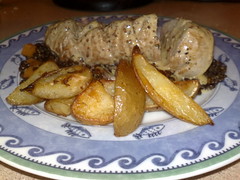Saturday 3 April
Pork is one of my favourite meats, and I’m often frustrated by people who claim it is dry and tough. Like most things, it’s all in the cooking and if you insist on turning your piece of pork into a crisp then, yes, it is dry and tough. But many people have a horror
I find pork fillet a little more tolerant than other cuts (with pork chops the most truculent), so even though it’s expensive I don’t find myself fretting when I cook it.
Unfortunately, though, pork fillet needs something doing to it … you can’t just fry it up and whack it on a plate like you can with a nice piece of steak. I turned to The Silver Spoon* for inspiration. This is a brilliant, Italian reference manual – most of the recipes are extremely simple, so you’ll either have all the ingredients for a dish or you’ll be able to muddle through with little difficulty. This is a great example of that simplicity.
First, heat some olive oil and butter in a pan and brown your pork fillet on all sides. Don’t play with it – pop it in the hot fat and leave it until it comes away of its own free will – that’s when it will be nicely brown. Once browned all over, put the pork in a baking dish and finish the cooking in a hot oven. At 180°C our 400g pork fillet took about 30 minutes: we did allow some resting time and we prefer our pork a little less cooked. If all else fails, jabbing a knife in the fattest part of the fillet should give you a good idea of how things are progressing.
While the pork is finishing in the oven, deglaze the pan with a generous splash of dry white wine** (I’d reckon at around the 100mL mark). Scrape up all the good brown bits from the bottom of the pan and reduce the wine by about half. Reduce the heat and add about 100mL of cream and a heaped teaspoon of grainy mustard. Stir or whisk to combine. You don’t need to be too fussed about quantities here – simply make as much sauce as you want and don’t forget to taste as you go along!
Set the sauce aside and reheat gently when the pork is ready. We served the fillet sliced on puy lentils, with roasted rosemary potato wedges. And, of course, the remainder of the bottle of white!
* The Silver Spoon is also available through Amazon US and Amazon UK
.
** I’d recommend using a white with a bit of weight and acidity, to match and cut through the creamy sauce. On this occasion I used a Hunter Valley Semillon with rather too much age on it. A younger Semillon would work really well, as would a very lightly oaked Chardonnay.

